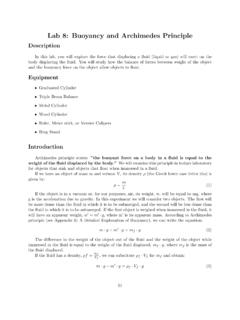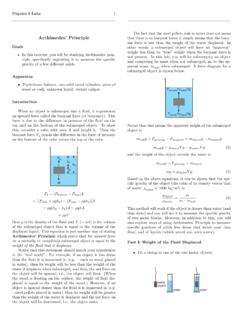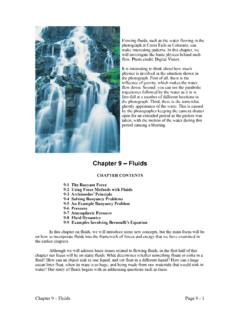Transcription of NPCA Buoyancy White Paper Section 1- Buoyancy Guide
1 NPCA Buoyancy White Paper Section 1- Buoyancy Guide Intro Buoyancy is defined as the tendency of a fluid to exert a supporting upward force on a body placed in a fluid ( , a liquid or a gas). The fluid can be a liquid, as in the case of a boat floating on a lake, or the fluid can be a gas, as in a helium-filled balloon floating in the atmosphere. An elementary application of Buoyancy can be seen when trying to push an empty water bottle downwards in a sink full of water. When applying a downward force to the water bottle from your hand, the water bottle will stay suspended in place. But, as soon as you remove your hand from the water bottle, the water bottle will float to the surface.
2 The buoyant force on the object determines whether or not a given object will sink or float in a fluid. It can be determined if an underground concrete structure will float or sink using basic principles and applying this to a concrete structure. Essentially a concrete structure will not float if the sum of the vertical downward forces (gravitational, W) is greater than the vertical upward force (buoyant, Fb). When applying this principle to a structure below grade, it can be said that; if the buoyant force (Fb) is greater than the mass of the structure and the combined mass of soil surcharges and objects contained within the structure, the structure will float.
3 People have been aware of objects floating or sinking in a fluid since the beginning of time. It wasn t officially documented and conceptually grasped until archimedes (287-212 ), established the theory of floatation and defined the Buoyancy principle. Apparently (while in his bath) archimedes realized that submerged objects always displace fluid upward (water in the bath rose while he was submerged). Then with that observation, he concluded that this force (buoyant) must be equal to the weight of the displaced fluid. archimedes then went on to state that a solid object would float if the density of the solid object was less than the density of the fluid and vice versa.
4 Figure 1 archimedes Principle So, why is Buoyancy an important factor in the design of an underground concrete structure? The simple answer is that the buoyant forces created by water need to be resisted to prevent the structure from floating or shifting upwards. This Guide will help direct the user through a series of standard calculations and procedures in order to determine if their underground concrete structure will resist buoyant forces. Section 2- Determining Water Table Levels Review Plans, Specifications, Soils Reports and Boring Logs When designing an underground precast concrete structure, it is necessary to know what structure to make as well as what its intended use is.
5 Typically a contractor who is in need of a precast structure will come to precasters with details on what they need and give design requirements and information on the underground conditions. But, not always do they inform precasters about every detail, especially job site conditions and problems in the construction area. Job site conditions and underground conditions are vital pieces of information needed for the design calculations to optimize the performance of the structure in the installed condition and to prevent floatation. So, how does the design engineer determine when there could be a potential problem with the jobsite conditions and with floatation?
6 First off, the design engineer should do his/her research to review and investigate the plans, specifications and soils reports to gain more insight about the project and the underground conditions. After obtaining the design requirements and specifications for the structural design the design engineer should obtain extensive information on the soils and underground conditions. One of the first factors that must be determined when analyzing an area, in which the concrete structure will be placed below grade, is the water table, ground water level. Obtaining this information will help the designers identify areas where flotation could potentially be a problem and areas where flotation will most likely not be a factor in the design.
7 So, how can one determine the water table level in the project area? The design engineer should check the soils report to obtain more information on the area. The soils report is most likely the most reliable source of information since it s based on a study of the jobsites conditions. If there isn t a soils report, core drilling may be necessary. By core drilling in the vicinity of the project, the depth of the water level from grade can be determined. It should be noted that ground water levels identified on boring reports are only a snap shot and may not account for seasonal variations. Another possible source of information would be from local well drillers.
8 They should maintain records of water table levels in areas which they drill. If there isn t any of the above information available, you may want to ask your local excavation contractors, since they have firsthand experience with ground water in the area. If you re out of options and you can t find out any of the above information, it is recommended to consider a design for water levels at grade, even if flooding in that area is not common. This is considered a conservative approach by many design engineers. A conservative design approach may offset unnecessary and unforeseen cost when sufficient information about the soil/site conditions is unavailable.
9 After the water table/level has been determined and it is known that there will most likely not be a problem with Buoyancy or flotation issues, the designer can focus in on maximizing the structure without buoyant forces being exerted on the structure. In most cases flotation will not be a problem in areas of the country without groundwater (parts of Texas, Arizona, Nevada, etc.), and where the ground water is below the anticipated depth of the structure. The fact that the Buoyancy force (Fb) exists presupposes that the water table at the site is believed to be some distance above the lowest point of the installed structure.
10 But, if your structure is to be placed above the ground water level (according to the sites water table), less concern is needed. On the other hand, areas where flotation causes potential problems are regions where the water level is at grade (valleys, ocean shores), and areas where ground water is present below grade, at time of installation (before soil has had a chance to become a solid mass). Be Aware of Seasonal and Regional Variations The water table is the upper level of an underground surface in which the soil is saturated with water. The water table fluctuates both with the seasons and from year to year because it is affected by climatic variations and by the amount of precipitation used by vegetation.









